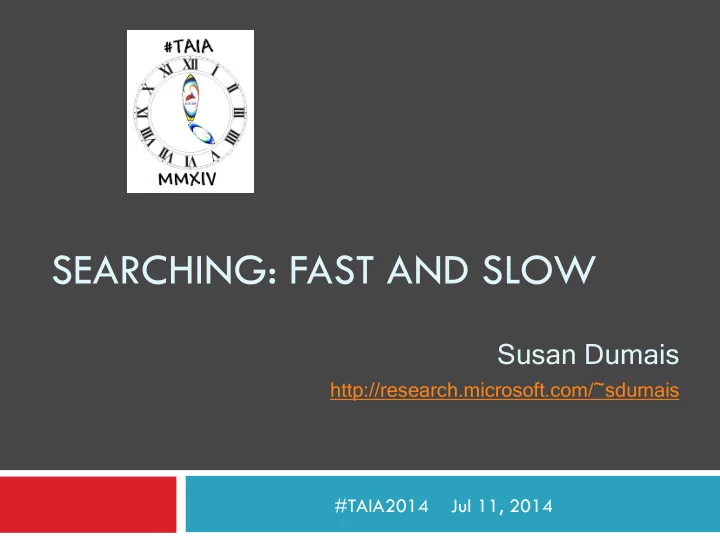

SEARCHING: FAST AND SLOW Susan Dumais http://research.microsoft.com/~sdumais #TAIA2014 Jul 11, 2014
Searching: Fast and Slow Tremendous engineering effort aimed at making search fast … and for good reason But, many compromises made to achieve speed Not all searches need to be fast How can we use additional time to improve search quality?
Speed Focus in Search Important Schurman & Brutlag, Velocity 2009 (Arapakis, Bai & Cambazoglu, SIGIR 2014) A/B tests increasing page load time (at server) Increasing page load time by as little100 msecs influences search experience substantially Decreased searches per user, clicks, and revenue Increased abandonment, and time to click Effects are larger with longer latency and persist after delays are removed
Schurman (Bing)
Brutlag (Google)
Brutlag (Google)
Speed Focus in Search Important Teevan et al., HCIR 2013 Examined naturally occurring variation in page load time (for same query), from 500-1500 msec Longer load time associated with increases in Abandonment rate increased (from 20% to 25%) Time first to click increased (from 1.2 to 1.6 secs) Larger effects on navigational (vs. informational) queries
Not All Searches Need to Be Fast Complex information needs Long search sessions Cross-session tasks Social search Question asking Technology limits Mobile devices Limited connectivity Search from Mars
Improving Search with More Time By the second Use richer query and document analysis Issue additional queries By the minute Include humans in the loop, e.g., to generate “answers” By the hour Create new search artifacts Enable new search experiences Relaxing time constraints creates interesting new opportunities for “search”
By the Second Use richer query and document analysis Issue additional queries Find additional answers on “quick back” … Especially helpful for Difficult queries Long sessions, whether struggling or exploring
Question Answering AskMSR question answering system Re-write query in declarative form E.g., “ Who is Bill Gates married to?” “Bill Gates +is married +to” <> 1. Melinda French 53% <> “+is married +to Bill Gates” 2. Microsoft Corp 16% 3. Mimi Gardner 8% “Bill Gates” AND “married to” “Bill” AND “Gates” AND “married” Mine n-grams from snippets, exploiting redundancy Are multiple queries worth the cost?
Decision-Theoretic QA Order query rewrites by their importance Assess cost and benefit of additional queries Aggregate results
By the Minute Use slower resources (like people) Can be used to augment many components of the search process Understanding the query Finding (or generating) better results Understanding (or organizing) results
People Can Provide Rich Input Study: Complex restaurant queries to Yelp People used to Support deeper understand of the query Organize results in a new way
Understand Query: Identify Entities Search engines do poorly with long, complex queries Query: Italian restaurant in Squirrel Hill or Greenfield with a gluten-free menu and a fairly sophisticated atmosphere Crowd workers identify important attributes Given list of potential attributes Option add new attributes Example: cuisine, location, special diet, atmosphere Crowd workers match attributes to query Attributes used to issue a structured search (to Yelp)
Understand Results: Tabulate Crowd workers tabulate search results Given a query, result, attribute, and value Does the result meet the attribute?
People Can Generate New Content Bing Answers “Tail” Answers
The Long Tail of Answers weather movies # occurrences Tail Answers sigir 2015 dates Information needs Hard to find structured information Not enough query volume for dedicated teams
Tail Answers Pipeline 1. Identify Answer Candidates (logs) Search trails that lead to same URL 2. Filter Candidates (crowd-powered) Navigational behavior Unambiguous needs Succinct answers 3. Generate Answers (crowd-powered) Extract Proofread Title Vote Vote Vote
Tail Answers Results Quality: 87% had no errors molasses substitute Time: minutes Cost: 44¢ to create answer Expt: result quality x presence of “tail answer” Tail Answers dissolvable stitches speed Change subjective ratings half as much as good ranking Fully compensate for poor rankings
By the Hour We can create new “search” experiences Support ongoing tasks Task resumption, across sessions or devices Reinstate context, generate summaries, highlight change Proactively retrieve information of interest Asynchronously answer search requests Dinner reservations for tonight Background material by morning
Support Task Resumption 10-15% of tasks continue across sessions Predict which tasks will be resumed at a later time Reinstate and enrich context Stops Resumes In Office On Bus Walking to bus stop Task Task (on PC) (on SmartPhone) ~20 minutes Task Continuation Predictor Resume task » New info found!! Better results found!
Searching: Fast and Slow Relaxing time constraints creates interesting opportunities to change “search” as we know it Especially useful for complex information needs that extend over time richer understanding and presentation of information Allows us to think about solutions that support differential computation (e.g., CiteSight) combine human and algorithmic components (e.g., TailAnswers, VizWiz) Requires that we break out of the search box
Thank You ! Questions/Comments ??? More info, http://research.microsoft.com/~sdumais
Further Reading The need for speed Schurman, E. and Brutlag, J. Performance related changes and their user impact. Velocity 2009 Conference. Arapakis, I., Shi, X. and Cambazoglu, B. Impact of response latency on user behavior in web search . SIGIR 2014. Slow search Teevan, J., Collins-Thompson, K., White, R., Dumais, S.T. and Kim, Y. Slow search: Information retrieval without time constraints. HCIR 2013. Azari, D., Horvitz, E., Dumais, S.T. and Brill, E. Actions, answers and uncertainty: A decision-making perspective on web question answering . IPM 2004. Lee, C-J., Teevan, J. and de la Chica, S. Characterizing multi-click search behavior and the risks and opportunities of changing results during use . SIGIR 2014. Bernstein, M., Teevan, J., Dumais, S.T., Libeling, D. and Horvitz, E. Direct answers for search queries in the long tail . CHI 2012. Wang, Y., Huang, X. and White, R. Characterizing and supporting cross-device search tasks. WSDM 2013.
Recommend
More recommend